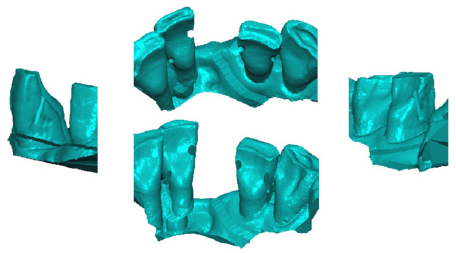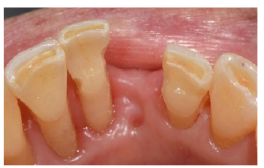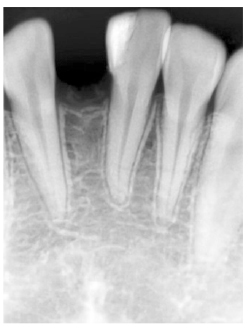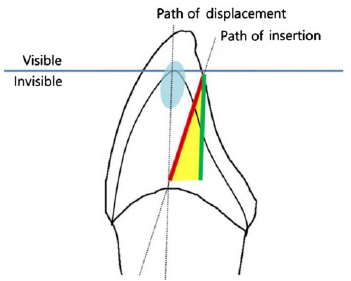J Korean Acad Prosthodont.
2017 Jul;55(3):325-330. 10.4047/jkap.2017.55.3.325.
Resin bonded fixed prosthesis for single tooth restoration: A case report
- Affiliations
-
- 1Department of Prosthodontics, College of Dentistry, Dankook University, Cheonan, Republic of Korea. hyuk928@dankook.ac.kr
- KMID: 2387207
- DOI: http://doi.org/10.4047/jkap.2017.55.3.325
Abstract
- In the case of single tooth replacement, a fixed prosthesis or a dental implant is the treatment option commonly selected as first choice. However, any amount of sound tooth structure should be removed to prepare the abutment teeth for full coverage retainer. The adjacent tooth damage can be avoided placing a dental implant. However, depending on the patient's oral condition and any other circumstances, it may be impossible or delayed. In this case resin bonded fixed partial denture was selected as an alternative that can restore single tooth loss without much tooth structure removal to the young patients and the patients with gingival recession. We report these patients were satisfied with esthetic and function.
MeSH Terms
Figure
Cited by 1 articles
-
Effects of primers on the microtensile bond strength of resin cements to cobalt-chromium alloy
Hong-Taek Jung, Shiela A. Campana, Jin-Hong Park, Joo-Hee Shin, Jeong-Yol Lee
J Korean Acad Prosthodont. 2019;57(2):95-101. doi: 10.4047/jkap.2019.57.2.95.
Reference
-
1. Jung RE, Zembic A, Pjetursson BE, Zwahlen M, Thoma DS. Systematic review of the survival rate and the incidence of biological, technical, and aesthetic complications of single crowns on implants reported in longitudinal studies with a mean follow-up of 5 years. Clin Oral Implants Res. 2012; 23:2–21.2. Zitzmann NU, Arnold D, Ball J, Brusco D, Triaca A, Verna C. Treatment strategies for infraoccluded dental implants. J Prosthet Dent. 2015; 113:169–174.
Article3. Newcomb GM. The relationship between the location of subgingival crown margins and gingival inflammation. J Periodontol. 1974; 45:151–154.
Article4. Lüthy H, Loeffel O, Hammerle CH. Effect of thermocycling on bond strength of luting cements to zirconia ceramic. Dent Mater. 2006; 22:195–200.
Article5. Zitzmann NU, özcan M, Scherrer SS, Bühler JM, Weiger R, Krastl G. Resin-bonded restorations: a strategy for managing anterior tooth loss in adolescence. J Prosthet Dent. 2015; 113:270–276.
Article6. Botelho M. Resin-bonded prostheses: the current state of development. Quintessence Int. 1999; 30:525–534.7. Rammelsberg P, Pospiech P, Gernet W. Clinical factors affecting adhesive fixed partial dentures: a 6-year study. J Prosthet Dent. 1993; 70:300–307.
Article8. Saad AA, Claffey N, Byrne D, Hussey D. Effects of groove placement on retention/resistance of maxillary anterior resin-bonded retainers. J Prosthet Dent. 1995; 74:133–139.
Article9. el-Mowafy OM. Posterior resin-bonded fixed partial denture with a modified retentive design: a clinical report. J Prosthet Dent. 1998; 80:9–11.
Article10. Moschèn I, Berger P, Falk M, Hörl R, Hörle M, Gausch K. Comparison of resin-bonded prosthesis groove parallelism with the use of four tooth preparation methods. J Prosthet Dent. 1999; 82:398–409.
Article11. Ries S, Wolz J, Richter EJ. Effect of design of all-ceramic resin-bonded fixed partial dentures on clinical survival rate. Int J Periodontics Restorative Dent. 2006; 26:143–149.12. Sasse M, Kern M. CAD/CAM single retainer zirconia-ceramic resin-bonded fixed dental prostheses: clinical outcome after 5 years. Int J Comput Dent. 2013; 16:109–118.13. Goodacre CJ, Bernal G, Rungcharassaeng K, Kan JY. Clinical complications in fixed prosthodontics. J Prosthet Dent. 2003; 90:31–41.
Article14. Corrente G, Vergnano L, Re S, Cardaropoli D, Abundo R. Resin-bonded fixed partial dentures and splints in periodontally compromised patients: a 10-year follow-up. Int J Periodontics Restorative Dent. 2000; 20:628–636.15. Yap AU, Stokes AN. Resin-bonded prostheses. Quintessence Int. 1995; 26:521–530.16. Pjetursson BE, Tan WC, Tan K, Brägger U, Zwahlen M, Lang NP. A systematic review of the survival and complication rates of resin-bonded bridges after an observation period of at least 5 years. Clin Oral Implants Res. 2008; 19:131–141.
Article
- Full Text Links
- Actions
-
Cited
- CITED
-
- Close
- Share
- Similar articles
-
- Zirconia resin-bonded fixed partial denture in maxillary single-tooth edentulous area: A case report
- Clinical perspectives on 2-unit cantilevered resin-bonded fixed partial denture
- Resin-bonded fixed partial denture using In-Ceram and Targis-Ventris system
- Chair-side CAD/CAM fabrication of a single-retainer resin bonded fixed dental prosthesis: a case report
- Influence of the amount of tooth surface preparation on the shear bond strength of zirconia cantilever single-retainer resin-bonded fixed partial denture















